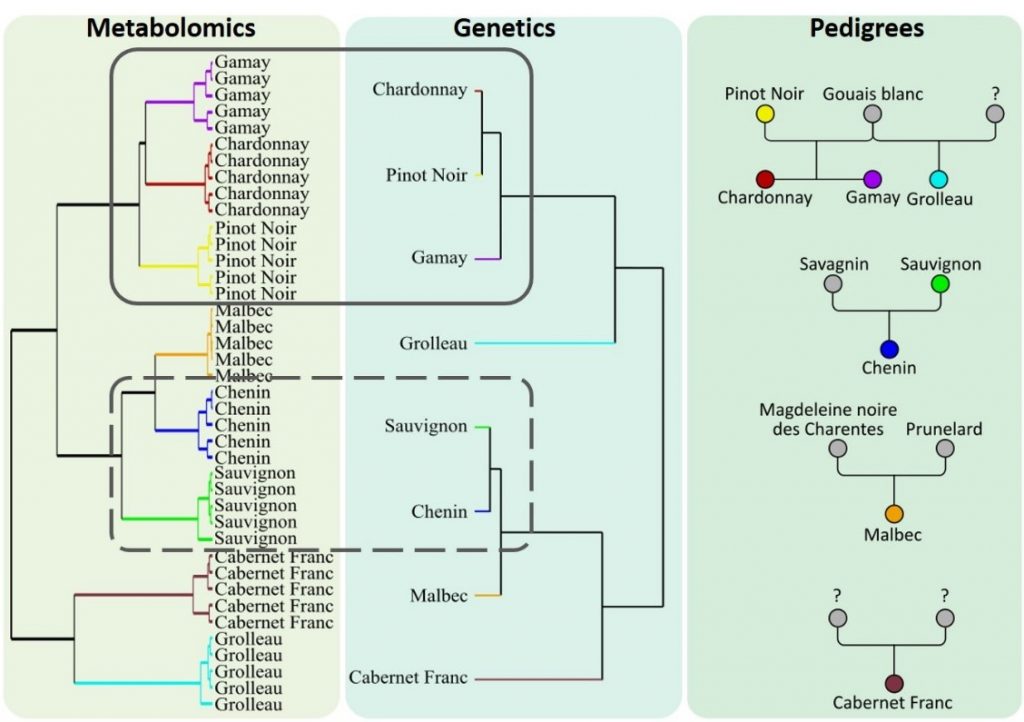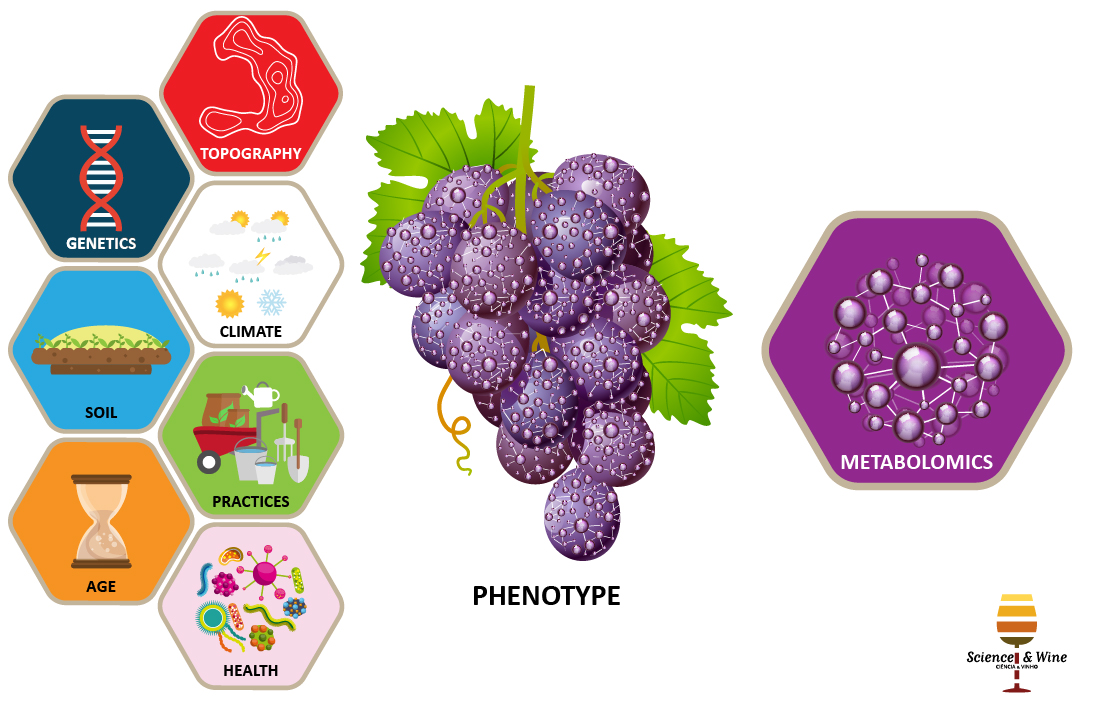By Arnaud Lanoue
Grape accumulates numerous polyphenols with abundant health benefit and organoleptic properties that in planta act as key components of the plant defense system against diseases. Besides ubiquitous phenolic compounds including flavonoids, hydroxycinnamates and benzoates, grapevine accumulated peculiar non-flavonoid compounds called stilbenoids. Grapevine accumulates stilbenoids mainly in lignified organs. By the way, the winter-pruned wood from vineyard has been proposed as a source of valuable bioactive compounds (Houillé et al 2014; 2015a; 2015b; Billet et al., 2018a).
Metabolomics is the systematic study of all small-molecular weight metabolites present within a cell, tissue or organism. Grape metabolomics has contributed greatly to the chemical characterization of wine (Flamini et al., 2013). Recently, the development of metabolomic approaches has led to the concept of metabolic phenotype that considers a metabolic profile as a result of the genotype expression under environmental conditions. It is particularly relevant for plant metabotypes based on specialized metabolites since they might vary according biotic and abiotic stresses.
In the present study (Billet et al., 2018b), a field experiment (Figure 1) was setting up with uniform pedo-climatic factors and viticultural practices of growing vines to favor the genetic determinism of polyphenol expression. We used UPLC-MS-based targeted metabolomics to identify the metabolic composition of grape stem that correspond to the main site of accumulation for stilbenoids in vines. Chemometric tools including principal component analysis (PCA), partial least square discriminant analysis (PLS-DA) and hierarchical cluster analysis (HCA) were used to identify the overall metabolomic similarity/dissimilarity among the samples. Metabolomic and SSR-based clusterings were compared to assess the relationship between biochemical and genetic distances.

As a result, metabolic profiles of grape stems enabled discrimination of varietal origin suggesting that polyphenol profiles exhibit variety-dependent metabolic fingerprints (Figure 2). HCA perfectly separated genotypic replicates but also grouped genotypes according to their biochemical distances, thus suggesting a classification in accordance with their genetic distance.
A first group of metabotypes (Gamay, Chardonnay, Pinot Noir) corresponds to closely related genotypes previously grouped called “Noirien” when defined as eco-geographical groups by ampelographers. A second group of metabotypes (Chenin, Sauvignon) belongs to the group called “Messile” originated in the French Loire Valley. Recently, these parentage relationships were confirmed by DNA sequence studies using SSR and SNP markers. Chardonnay and Gamay are full-siblings of Pinot noir and Gouais Blanc and Chenin is a possible natural cross of between Sauvignon and Savagnin.
Field-based metabolomic experiments may reflect real growth conditions, however such investigations are challenging because the metabotype reflects both genetic and environmental conditions. In the present field experiment, the genotypic discrimination was achieved using a harvest protocol that limits the effect of environmental conditions and highlights variations due to the genotype. Because, polyphenol content in grape stems might be locally induced in response to pathogen attacks, the quality of sampling design in the vineyard is determinant to limit intra-plot variations.
Dealing with the different sources of variability in real growing conditions (genotypes, environment and management interventions) constitutes one of the future challenges for field-omics. In a near future, the present polyphenol metabotyping approach coupled to multivariate statistical analyses might assist grape selection programs to improve metabolites with health-benefit potential and plant defense traits.

Those interested in a longer length report can download the working paper at:
https://www.ncbi.nlm.nih.gov/pmc/articles/PMC6021511/
References:

Dr. Arnaud Lanoue is a phytochemical analyst. He obtained a joint Ph.D. at the Universities of Amiens (France) and Geneva (Switzerland) in 2002 on the bioproduction of plant specialized metabolites. He conducted postdoctoral research at the Juelich Research Center (Germany) on plant natural products as signaling molecules within the Biorhiz project (Marie Curie actions-Research Training Networks). Since 2007, he is Associate Professor at the Faculty of Pharmacy in the University of Tours (France) in the Lab “Biomolecules and Plant Biotechnologies” (@BBVEA2106_Tours, Plant & Biotech Lab – BBV Ea2106 Tours) where is leading several research programs on the valorization of grape polyphenols.
References:
- Billet, K., Houillé, B., Besseau, S., Mélin, C., Oudin, A., Papon, N., et al. (2018a). Mechanical stress rapidly induces E-resveratrol and E-piceatannol biosynthesis in grape canes stored as a freshly-pruned byproduct. Food Chem. 240, 1022–1027. doi: 10.1016/j.foodchem.2017.07.105
- Billet, K., Houille, B., Dugé de Bernonville, T., Besseau, S., Oudin, A., Courdavault, V., et al. (2018b). Field-based metabolomics of Vitis vinifera L. Stems Provides New Insights for Genotype Discrimination and Polyphenol Metabolism Structuring. Front. Plant Sci. doi: 10.3389/fpls.2018.00798.
- Flamini, R., De Rosso, M., De Marchi, F., Dalla Vedova, A., Panighel, A., Gardiman, M., et al. (2013). An innovative approach to grape metabolomics: stilbene profiling by suspect screening analysis. Metabolomics 9(6), 1243-1253. doi: 10.1007/s11306-013-0530-0.
- Houillé, B., Papon, N., Boudesocque, L., Bourdeaud, E., Besseau, S., Courdavault, V., et al. (2014). Antifungal activity of resveratrol derivatives against candida species. J. Nat. Prod. 77, 1658–1662. doi: 10.1021/np5002576
- Houillé, B., Besseau, S., Courdavault, V., Oudin, A., Glévarec, G., Delanoue, G., et al. (2015a). Biosynthetic origin of E-resveratrol accumulation in grape canes during postharvest storage. J. Agric. Food Chem. 63, 1631–1638. doi: 10.1021/jf505316a
- Houillé, B., Besseau, S., Delanoue, G., Oudin, A., Papon, N., Clastre, M., et al. (2015b). Composition and tissue-specific distribution of stilbenoids in grape canes are affected by downy mildew pressure in the vineyard. J. Agric. Food Chem. 63, 8472–8477. doi: 10.1021/acs.jafc.5b02997

